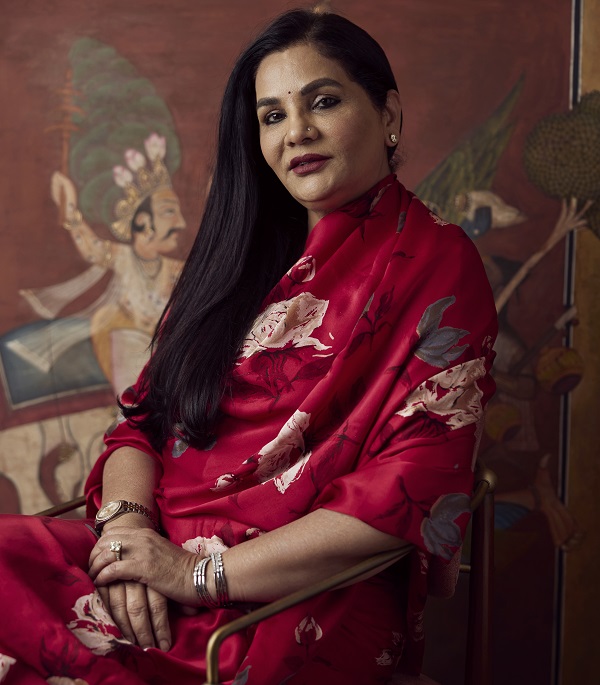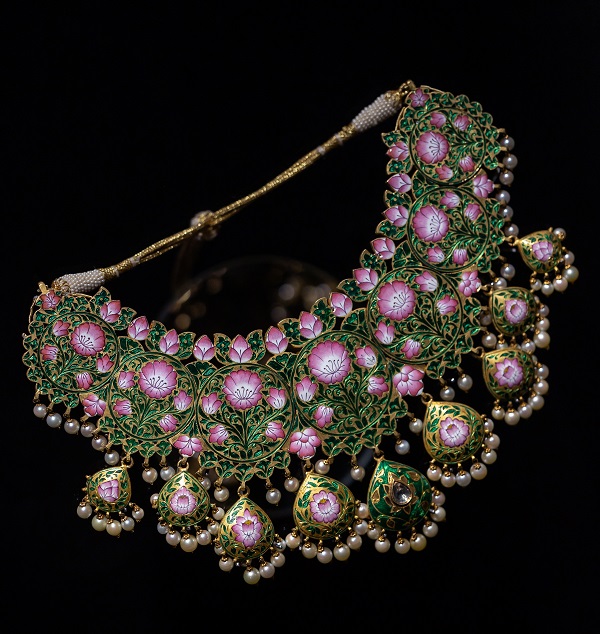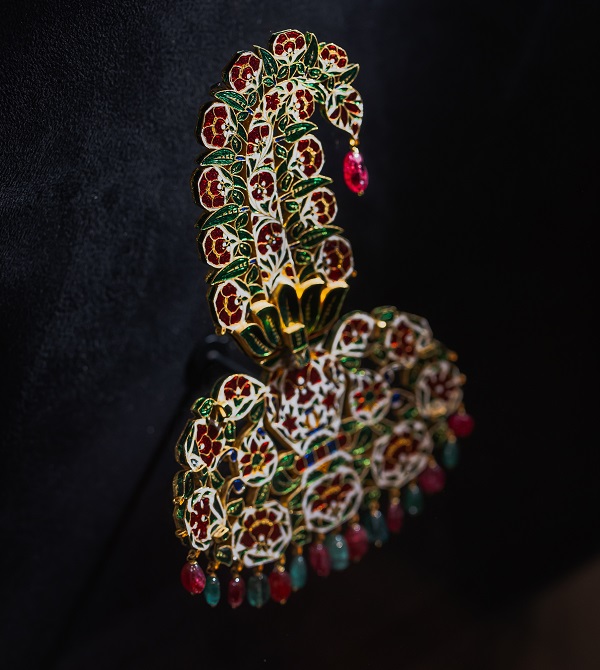Showcasing famed jewellery designer Sunita Shekhawat’s 25-Year Journey in Meenakari Mastery—rooted in tradition yet destined to be reimagined.

India has always kept the world at sway with its aesthetic craftsmanship and traditional offerings. Among its vast repertoire of symbols of heritage and cultural identity the gems and jewellery sector continues to remind us about India’s rich and diverse past with a strong spirit of resilience and continuity to churn timeless, eclectic and truly unique pieces.
The sector is held with much significance as it contributes around 7% to the GDP and also provides a very healthy ecosystem for employability with an estimated figure of over 5 million workforces. The export figures in April-September 2024 reached US$13.40 billion. The government has strongly backed the sector’s growth by assisting in setting up production and design centres and testing facilities.
The recently announced Union Budget was largely seen as a boost to the domestic market. Being one of the largest consumers of jewellery India also enjoys a significant share in the global market when it comes to exporting both uncut and polished gems.
Among the different methods and style of jewellery making Meenakari stands prominent enthralling lovers of the art of etching and colouring with enamelling. It is a painstakingly long process involving hot enamelling and gold foiling techniques finishing in a product that stitches tradition, sentiment, style and timelessness.
And when it comes to Meenakari the city of Jaipur gets a mention as it’s the hub where all the action lies having first been brought to the city by Raja Man Singh of Amber after the art was introduced in India by the Mughals. Among the names who have been working with this art with a quiet determination, and innovative spirit, Sunita Shekhawat is an impressive figure in the sector not just for her eclectic brand of sophisticated items but for her consistency in putting forth class and quality that have held her customers in awe. Based in Jaipur her eponymous brand has come to occupy a place for heritage heirlooms and completed 25 years in 2024 since it opened its door.
In celebration of achieving this milestone Sunita inaugurated the Museum of Meenakari Heritage at the Shekhawat Haveli, Jaipur. The MOMH now stands as an aesthetic confluence of history, architecture, immersive and customized retail experience of the charm that is Meenakari. Let’s hear from Sunita in a Q and A for a better insight into her work and views.
You have successfully completed 25 years of excellence in the Indian gem and jewellery industry. How has the journey evolved over the years?
Completing 25 years in the Indian gem and jewellery industry has been an incredible journey. From starting with traditional designs to embracing modern innovations, we've seen immense growth. Along the way, we've focused on sustainability, ensuring our creations are not only beautiful but responsible. The support of our loyal customers has been the key to our success, and I'm proud of how far we've come. Looking ahead, we're committed to continuing our journey with the same passion and dedication to excellence.
With your deep appreciation for art, cultural diversity, and artisanal heritage, you have gifted the country MOMH. What has been the response from art lovers, architects, researchers, foreign visitors, curators, and emerging professionals aspiring to join this sector?
The response to MOMH has been overwhelmingly positive. Art enthusiasts, researchers, and foreign visitors are deeply engaged, gaining a thought-provoking experience while discovering the cultural heritage behind the unique art of Meenakari. We have made the museum accessible to all, ensuring everyone can enjoy this immersive experience. What truly sets MOMH apart is that every material used in the museum is exclusively sourced from Rajasthan, celebrating the rich artistic legacy of Jaipur and its skilled artisans.
In your pursuit of developing an eclectic range of Meenakari jewellery, how do you balance traditional aesthetics with innovation to remain relevant in today’s competitive market?
Preserving traditional crafts is deeply important to me. By blending my respect for heritage with modern innovation, we ensure that these valuable skills not only survive but thrive for the future generations. Through the Museum of Meenakari Heritage, I strive to honour and showcase this rich tradition, ensuring its distinctive beauty and craftsmanship are celebrated and valued. Our collection like the, ‘Padmapriya’ and ‘Neelkamal’ feature vibrant lotus inspired colours. We also include floral motifs like the ‘Carnation’ uses the Meenakari technique and ‘Bougainvillea’ using the French enamelling technique plique-à-jour to bring the Indian bougainvillea flower to life, combining artistic flair with traditional craftsmanship.

In an era of opulent destination weddings and digital retail, how do you ensure sustainability while offering a premium jewellery-buying experience?
In an era of luxurious destination weddings and digital retail, we prioritize sustainability by focusing on the craftsmanship and emotional value behind each piece of jewellery. Every design is created with the intention of being timeless—something that can be passed down through generations as a lasting legacy. While ensuring sustainability in our materials and processes, we also provide a premium experience by offering personalized service. We empower our customers to make their jewellery truly unique, allowing them to add their own design touch while receiving the highest level of care and attention throughout their selection process.
What are the strengths and challenges of working with niche artisans, particularly in preserving tradition amid large-scale manufacturers replicating original designs?
Working with niche artisans allows us to offer authentic, high-quality jewellery with deep cultural significance, preserving traditional craftsmanship. However, the challenge lies in mass manufacturers replicating these designs, often compromising on quality and originality. As a brand, we strive to balance innovation with tradition, ensuring the unique value of artisanal pieces is protected while meeting modern demands for luxury and craftsmanship.

What is your vision for the future, and what advice would you offer to young designers and aspiring professionals entering this industry?
My vision for the future is to see luxury in India evolve beyond material possession into a deeply immersive, personalized experience. As India continues to be a global hub for opulence, the future of luxury will be shaped by those who can connect with consumers on a more emotional and experiential level. For young designers and aspiring professionals entering this industry, my advice is to focus on authenticity and innovation. Embrace the rich cultural heritage of India while pushing boundaries to create unique, meaningful experiences that resonate with customers on a personal level.
For more information, log onto her website: https://www.sunitashekhawat.com